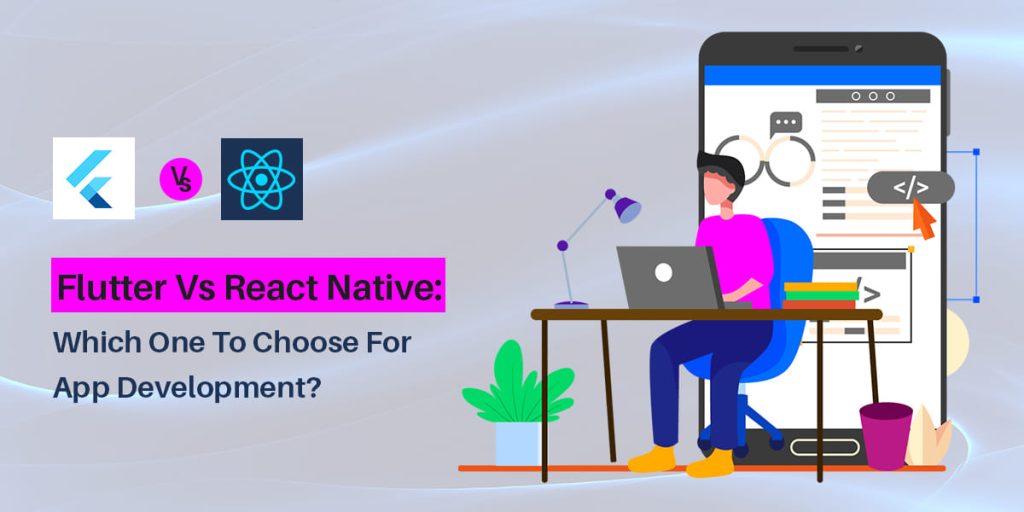When it comes to your next development project, it might be difficult to decide whether to use Flutter or React Native. Both have their advantages and disadvantages. It is all too tempting to jump on the current trends in the world of technology, particularly when new frameworks roll out with new pre-coded modules and promises of lightning-fast performance. This is especially true when new frameworks come out.

As per Statista, 38% of developers used React Native in 2021, whereas 42% used Flutter for development. When contrasting these two, one must often choose between the adjectives “great” and “wonderful.”
However, there are some subtle distinctions between the two platforms, and in this article, we’ll go through how to compare Flutter and React Native so that you may choose the most appropriate option for the next project you work on.
The Fundamentals of Flutter
The framework was developed by Google in 2017, and it is meant to function across platforms. This allows it to be represented on any mobile device, as well as tie into any online apps that you may already have. It is widely regarded to be one of the most successful open-source frameworks that are now accessible because, in large part, of the influence of Google.
Because of its numerous benefits, such as a full ecosystem for application development, the ability to do a hot reload, and the fact that it is open-source and free to use, Flutter is an excellent option for the creation of decentralized applications (Dapps).
Despite all of this, however, it does have several drawbacks, the most notable of which are its huge size and its dependency on local tools and technology.
The Fundamentals of React Native
This framework is a well-used, well-loved cross-platform app development technology that at the current time is one of the most popular frameworks in the world. It was developed by Facebook in 2015 and was released the same year. Why is it so popular?
The primary reason for this is its versatility, which enables developers to combine the usage of React and JavaScript with a wide variety of additional capabilities intrinsic to the platform for developing mobile applications.
This very dependable open-source framework features simple implementation of native user interface components, platform-specific code, quick reloading, and one of the most extensive user interface support groups found anywhere in the world. The simplicity of its hundreds of plug-and-play program components is highly valued by software developers.
Flutter Vs React Native
Here are some pointers for the distinction to make your task easier to choose between the two-
- Architecture
Flutter- Skia
Within a platform-specific shell, the framework makes use of the 2D graphics rendering toolkit Skia, as well as the Dart language virtual machine. It creates native code by compiling the source code for Dart before the actual runtime. This is a really important aspect. Its code is a solution that is both sophisticated and quick, and it integrates well with iOS or Android.
There is no cumbersome programming that has to be done in order to make things function. If we just consider one aspect of the competition between React Native and Flutter, it is abundantly evident that the former is the clear victor due to the elegance of its design.
React Native – Flux
This framework makes advantage of Facebook’s Flux design, however in order to incorporate it, a JavaScript bridge is necessary. Because of this annoying reality, app creation in Flutter moves at a little slower pace than it does in Dart. This is one of the primary distinctions between Flutter and React Native.
- Installation
Flutter
In order to install this framework, you will need to obtain the binary file from GitHub, which corresponds to the operating system on which you want to run it. If you are doing the installation for macOS, there is an extra step that must be completed in this section.
An additional.zip file must be downloaded, and it must be added as a PATH variable. This is one of the primary distinctions between Flutter and React Native, and it results in a more difficult and time-consuming installation process.
React Native
This framework is quite user-friendly when it comes to the installation process. If you are proficient in JavaScript and use the node package manager, the installation process will go off without a hitch.
It is essential to point out that none of these frameworks comes with native package management for operating systems or a one-line installation option. That indicates that neither model is perfect with regard to this topic.
However, the installation of Flutter requires one more step to be taken. In light of this, if there is a choice to be made between React Native and Flutter, we will always go with React.
- User Interface and Programming API
Flutter
This is a framework that depends heavily on its very own specialized programming language for the majority of its functionality. Because of this, the experience of developing a UI using the best flutter app development service and React Native is completely different from one another.
React Native
Components developed in-house or by a third party are used by React Native. The impact on the code is often inconsistent and patchy as a consequence.
But it’s vital not to overreact to this, since the JavaScript programming language that React uses has its own set of benefits that are distinct from those offered by other languages. Flutter, on the other hand, emerges victorious when pitted against React Native in terms of which mobile app development framework is superior.
- Development Time
Flutter
Developers do not utilize or understand the Dart programming language to the same extent as other languages. This framework is not supported by a large number of text editors and integrated development environments (IDEs), which makes the development process longer. However, the vast majority of users like its quick reload capability.
React Native
The distinction between Flutter and React Native can be boiled down to one thing: pure and straightforward JavaScript. Also, it should be noted that JavaScript makes development simpler and more approachable for a wider variety of efficient react native app development companies.
- Quality Assurance
Flutter
Flutter, like many other programs built by Google, has an extensive collection of integrated testing capabilities for quality control. Do you want to test only one widget at a time? You can.
Are you interested in running Integration tests? No issue. It is equipped with all of these capabilities. And to make matters even better, it offers a wealth of comprehensive documentation for testing.
React Native
This framework has an embarrassingly inadequate amount of built-in support for unit testing. Having stated that software developers may often fill up this void by making use of third-party frameworks such as Jest and Detox. It’s an add-on, but integrating it shouldn’t provide too much of a challenge.
- DevOps Support
Flutter
When comparing the DevOps capabilities of Flutter vs React Native, the majority of users would say that React Native is above Flutter. However, where Flutter falls short in terms of community support, it makes up for in official documentation for CI and CD.
The framework has a full section on this documentation, as well as various links, which makes the process of adding CI/CD for its applications very straightforward and simple. Although this is not a suitable replacement for extensive help from the development community, it is a nice place to start. It is expected that in the next few years, more people will make use of it.
React Native
Because of its relationship with Facebook, React Native now offers a vast collection of third-party libraries, as well as help manuals, third-party support, and more. When it comes to assistance for development and operations, React Native is, without a doubt, the best option.
Conclusion
In spite of the fact that React developers are more readily available, considerable consideration should be given to using Flutter as a React Native alternative due to the fact that Google is behind it.
While the creation of Google’s cross-platform mobile apps depends on the Dart compiler, the development of React Native apps relies on WebView and a JavaScript layer, which essentially slows down a React Native mobile app. Flutter has its very own rendering engine, which allows the production of designs that are really one-of-a-kind but comes at the cost of an increased overall weight for the project.
The usage of native components, which may need further customization by hand, is not permitted while working with React Native. In contrast, a React app has to make use of a web interface in order to transition from the mobile environment to the desktop environment.



Thanks for the valuable info! Now I can make an informed choice.